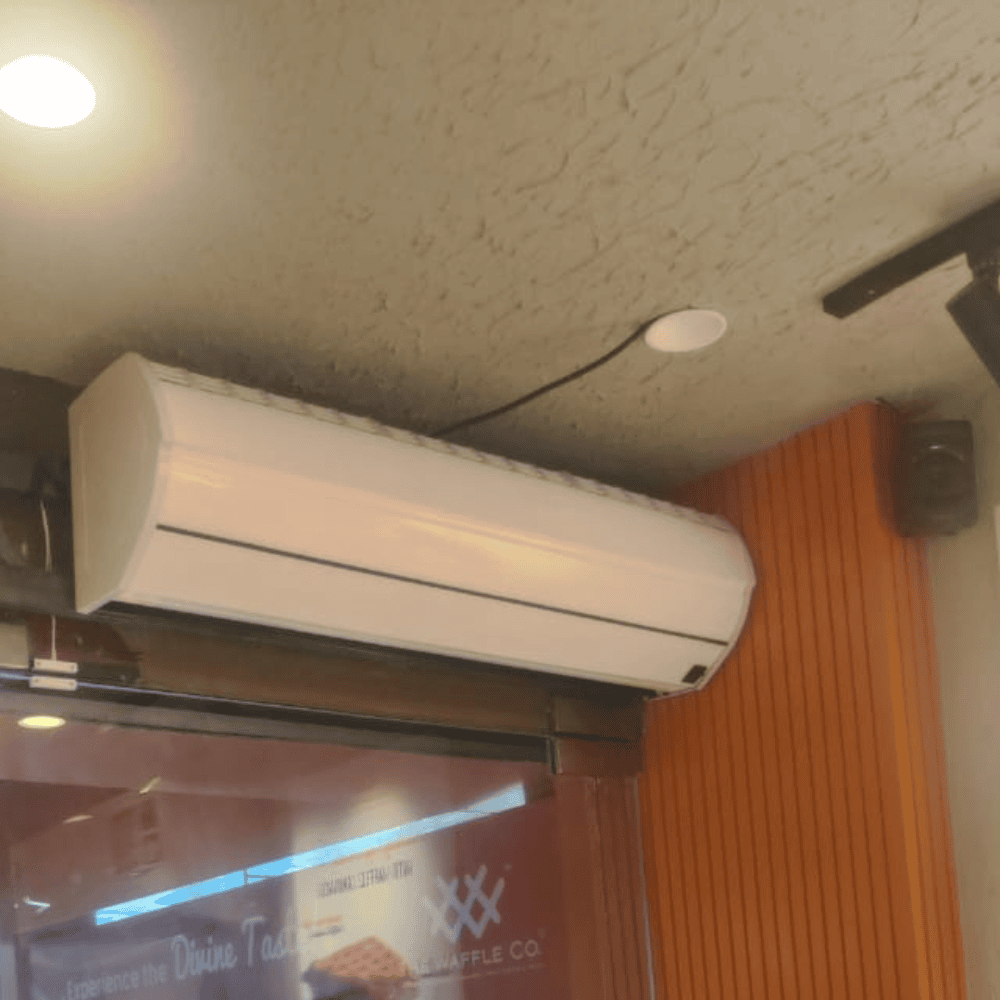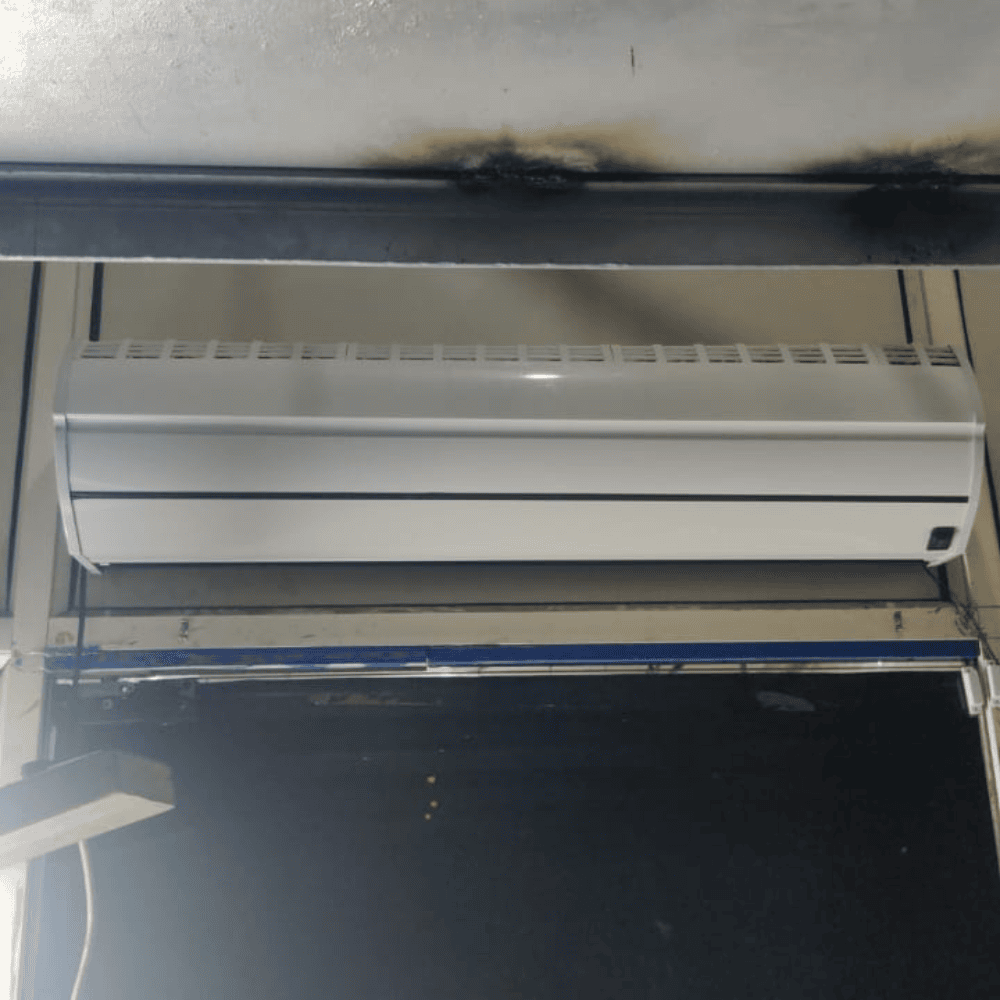Air Curtains for Your Commercial Kitchen: An Overview
Air Curtains for Your Commercial Kitchen: An Overview
- Maintain Temperature: Keep your kitchen cool in the summer and warm in the winter, preventing energy loss and saving you money.
- Keep Out Pests: Flies, mosquitoes, and other flying insects are a major nuisance in kitchens. Air curtains effectively block them from entering, improving hygiene and food safety.
- Improve Air Quality: Air curtains help to prevent dust, fumes, and odors from entering the kitchen, maintaining a cleaner and more pleasant working environment.
A commercial kitchen is a busy, demanding environment. Maintaining a comfortable temperature, keeping out pests, and ensuring hygiene are all critical for a successful operation. Air curtains can help you achieve these goals and more.
What is an air curtain?
Imagine an invisible door made of air. That's essentially what an air curtain is! It's a device installed above a doorway that blows a continuous stream of air downwards, creating a barrier between two spaces. This barrier helps to:
Where can air curtains be used in a commercial kitchen?
Where can air curtains be used in a commercial kitchen?
Air curtains can be strategically placed in various locations throughout a commercial kitchen to maximize their benefits. Here are some of the most common and effective placements:
1. Entrance Doors: This is perhaps the most common location for an air curtain in a commercial kitchen. It helps to:
- Separate the kitchen from the dining area: Maintain different temperatures and prevent kitchen noise and odors from reaching customers.
- Keep out dust, fumes, and flying insects: Prevent contaminants from entering the kitchen from outside, ensuring a cleaner and more hygienic food preparation environment.
2. Back Doors: Installing air curtains on back doors leading to delivery areas or waste disposal areas can:
- Maintain temperature: Prevent the loss of conditioned air and the entry of outside air when doors are opened for deliveries or waste removal.
- Prevent pests: Stop flies, rodents, and other pests from entering the kitchen through these frequently used doors.
3. Walk-in Coolers and Freezers: Air curtains over the doorways of walk-in coolers and freezers are highly beneficial. They:
- Minimize temperature fluctuations: Reduce the amount of cold air that escapes and warm air that enters when the doors are opened, helping to maintain the optimal temperature inside and reduce energy consumption.
- Prevent condensation and ice buildup: By minimizing air exchange, air curtains help to reduce humidity and prevent the formation of condensation and ice on surfaces inside the cooler or freezer.
4. Serving Areas: In kitchens with open serving areas or pass-through windows, air curtains can:
- Create a comfortable environment: Maintain a comfortable temperature for both staff and customers in the serving area.
- Protect food from contaminants: Prevent flying insects from reaching food on display or being prepared in open kitchens.
5. Dishwashing Areas: Air curtains in dishwashing areas can help to:
- Contain heat and humidity: Prevent excessive heat and humidity from spreading to other parts of the kitchen.
- Reduce odors: Help to contain and minimize odors associated with dishwashing.
Why are air curtains beneficial for commercial kitchens?
Why are air curtains beneficial for commercial kitchens?

Air curtains are a fantastic addition to commercial kitchens for a variety of reasons. They offer a multitude of benefits that can significantly improve the working environment, boost efficiency, and even save you money. Here's a breakdown of why they're so beneficial:
1. Temperature Control and Comfort:
- Maintaining ideal temperatures: Commercial kitchens can get incredibly hot, especially during busy periods. Air curtains help maintain a consistent and comfortable temperature by preventing the escape of cool air and the influx of hot air from outside. This ensures a more pleasant working environment for your staff, which can improve morale and productivity.
- Reducing drafts: Air curtains eliminate drafts that can make staff feel chilly and uncomfortable, especially those working near doorways. This contributes to a more consistent and comfortable environment.
2. Hygiene and Food Safety:
- Keeping pests out: Flies, mosquitoes, and other flying insects are a major concern in kitchens, as they can contaminate food and spread diseases. Air curtains act as an effective barrier, preventing these pests from entering and compromising food safety.
- Improving air quality: Air curtains help to prevent dust, fumes, and odors from entering the kitchen, maintaining a cleaner and more hygienic environment. This is crucial for complying with food safety regulations and ensuring the quality of your food.
3. Energy Savings:
- Reducing energy loss: Air curtains help to minimize energy loss by preventing the escape of conditioned air and the entry of outside air. This can lead to significant savings on your energy bills, especially in kitchens where doors are frequently opened and closed.
- Optimizing HVAC efficiency: By reducing the load on your heating and cooling systems, air curtains can help your HVAC system operate more efficiently, prolonging its lifespan and reducing maintenance costs.
4. Improved Efficiency and Productivity:
- Faster workflows: Air curtains allow for quicker and more efficient movement of staff and goods in and out of the kitchen, as doors can be left open for longer periods without compromising temperature or hygiene.
- Reduced downtime: By maintaining a comfortable temperature and preventing equipment breakdowns caused by temperature fluctuations, air curtains can help minimize downtime and ensure smooth kitchen operations.
- Maintaining ideal temperatures: Commercial kitchens can get incredibly hot, especially during busy periods. Air curtains help maintain a consistent and comfortable temperature by preventing the escape of cool air and the influx of hot air from outside. This ensures a more pleasant working environment for your staff, which can improve morale and productivity.
Choosing the right air curtain for your commercial kitchen

Choosing the right air curtain for your commercial kitchen is crucial to maximize its effectiveness and ensure you get the best return on your investment. Here's a breakdown of the key factors to consider:
1. Size and Type of Doorway:
- Width: The air curtain should be wide enough to cover the entire width of the doorway, creating a complete barrier. If the air curtain is too narrow, air can escape or enter around the sides.
- Height: The height of the doorway is also important. Higher doorways require more powerful air curtains to effectively reach the floor and create a strong barrier.
- Type: Consider the type of doorway. Is it a single door, double doors, a swinging door, or a high-speed roll-up door? Different door types may require specific air curtain configurations.
2. Air Velocity and Volume:
- Velocity: The air velocity should be strong enough to create an effective barrier against outside air and pests. Look for air curtains with adjustable velocity settings to fine-tune the airflow based on your needs.
- Volume: The air volume, measured in cubic feet per minute (CFM), indicates how much air the curtain moves. Larger doorways and higher ceilings require air curtains with higher CFM ratings.
3. Heating Options:
- Ambient: Ambient air curtains use unheated air to create a barrier. They are suitable for areas where temperature separation is the primary goal, such as between the kitchen and dining area.
- Heated: Heated air curtains provide an additional layer of comfort by blowing warm air. They are ideal for entrances exposed to cold weather or for maintaining a comfortable temperature in areas like serving counters.
4. Noise Level:
- Decibel rating: Air curtains can generate noise, which can be disruptive in a busy kitchen. Look for models with lower decibel ratings for quieter operation.
5. Installation and Maintenance:
- Ease of installation: Consider the ease of installation. Some air curtains are designed for easy DIY installation, while others may require professional help.
- Maintenance requirements: Choose an air curtain that is easy to clean and maintain. Look for features like removable filters and easy-access panels for hassle-free maintenance.
6. Special Features:
- Pest control: Some air curtains are specifically designed with pest control features, such as higher air velocity or UV light technology, to enhance their effectiveness in keeping out flying insects.
- Automatic door sensors: Air curtains with automatic door sensors activate the airflow only when the door is open, saving energy and reducing wear and tear.
- Remote control: Remote control functionality allows for convenient operation and adjustment of the air curtain settings.
7. Budget:
- Cost-effectiveness: Air curtains come in a wide range of prices. Consider your budget and look for a model that offers the best value for your needs. Don't forget to factor in the potential energy savings and improved efficiency that an air curtain can provide.
Conclusion : Importance of air curtain for your commercial kitchen
In conclusion, air curtains are a valuable asset for any commercial kitchen. They offer a multitude of benefits that go beyond simply keeping flies out. By creating an invisible barrier over doorways, air curtains help maintain a comfortable and consistent temperature, improve hygiene and food safety, and contribute to significant energy savings.
Investing in the right air curtain for your specific needs can lead to:
- Improved staff comfort and productivity: A more comfortable working environment can boost staff morale and efficiency.
- Enhanced hygiene and food safety: By keeping out pests and airborne contaminants, air curtains help maintain a clean and hygienic kitchen, reducing the risk of food contamination.
- Reduced energy costs: Air curtains help minimize energy loss, leading to lower heating and cooling expenses.
- Increased operational efficiency: Faster workflows and reduced downtime contribute to smoother kitchen operations.
Ultimately, air curtains are a smart investment that can pay off in multiple ways. They contribute to a more efficient, hygienic, and comfortable commercial kitchen environment, benefiting both your staff and your bottom line.

